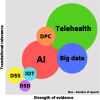Applications of digital health for public health responses to COVID-19: a systematic scoping review of artificial intelligence, telehealth and related technologies
- PMID: 33637833
- PMCID: PMC7910557
- DOI: 10.1038/s41746-021-00412-9
Applications of digital health for public health responses to COVID-19: a systematic scoping review of artificial intelligence, telehealth and related technologies
Abstract
The coronavirus disease 2019 (COVID-19) pandemic has overwhelmed healthcare services, faced with the twin challenges in acutely meeting the medical needs of patients with COVID-19 while continuing essential services for non-COVID-19 illnesses. The need to re-invent, re-organize and transform healthcare and co-ordinate clinical services at a population level is urgent as countries that controlled initial outbreaks start to experience resurgences. A wide range of digital health solutions have been proposed, although the extent of successful real-world applications of these technologies is unclear. This study aims to review applications of artificial intelligence (AI), telehealth, and other relevant digital health solutions for public health responses in the healthcare operating environment amidst the COVID-19 pandemic. A systematic scoping review was performed to identify potentially relevant reports. Key findings include a large body of evidence for various clinical and operational applications of telehealth (40.1%, n = 99/247). Although a large quantity of reports investigated applications of artificial intelligence (AI) (44.9%, n = 111/247) and big data analytics (36.0%, n = 89/247), weaknesses in study design limit generalizability and translation, highlighting the need for more pragmatic real-world investigations. There were also few descriptions of applications for the internet of things (IoT) (2.0%, n = 5/247), digital platforms for communication (DC) (10.9%, 27/247), digital solutions for data management (DM) (1.6%, n = 4/247), and digital structural screening (DS) (8.9%, n = 22/247); representing gaps and opportunities for digital public health. Finally, the performance of digital health technology for operational applications related to population surveillance and points of entry have not been adequately evaluated.
Conflict of interest statement
D.G. reports equity investment in digital health solutions AskDr, Doctorbell (acquired by Mobile Health), VISRE, and Shyfts, and appointments as physician leader (telemedicine) in Raffles Medical Group and senior lecturer (medical innovation) at the National University of Singapore. T.W. holds patents of deep learning systems for detection of eye diseases. T.W. is the deputy group chief executive officer (research and education) of Singapore Health Services, a consultant & advisory board for Allergan, Bayer, Boehringer-Ingelheim, Genentech, Merck, Novartis, Oxurion (formerly ThromboGenics), Roche, and co-founder of plano and EyRiS. The remaining authors R.T. and Y.T. declare no competing financial interests.
Figures


Similar articles
-
Qualitative evidence synthesis informing our understanding of people's perceptions and experiences of targeted digital communication.Cochrane Database Syst Rev. 2019 Oct 23;10(10):ED000141. doi: 10.1002/14651858.ED000141. Cochrane Database Syst Rev. 2019. PMID: 31643081 Free PMC article.
-
Australia in 2030: what is our path to health for all?Med J Aust. 2021 May;214 Suppl 8:S5-S40. doi: 10.5694/mja2.51020. Med J Aust. 2021. PMID: 33934362
-
Application of artificial intelligence in active assisted living for aging population in real-world setting with commercial devices - A scoping review.Comput Biol Med. 2024 May;173:108340. doi: 10.1016/j.compbiomed.2024.108340. Epub 2024 Mar 18. Comput Biol Med. 2024. PMID: 38555702
-
Exploring conceptual and theoretical frameworks for nurse practitioner education: a scoping review protocol.JBI Database System Rev Implement Rep. 2015 Oct;13(10):146-55. doi: 10.11124/jbisrir-2015-2150. JBI Database System Rev Implement Rep. 2015. PMID: 26571290
-
Artificial intelligence technologies and compassion in healthcare: A systematic scoping review.Front Psychol. 2023 Jan 17;13:971044. doi: 10.3389/fpsyg.2022.971044. eCollection 2022. Front Psychol. 2023. PMID: 36733854 Free PMC article.
Cited by
-
Feasibility of wearable sensor signals and self-reported symptoms to prompt at-home testing for acute respiratory viruses in the USA (DETECT-AHEAD): a decentralised, randomised controlled trial.Lancet Digit Health. 2024 Aug;6(8):e546-e554. doi: 10.1016/S2589-7500(24)00096-7. Lancet Digit Health. 2024. PMID: 39059887 Free PMC article. Clinical Trial.
-
Health Technology Assessment for In Silico Medicine: Social, Ethical and Legal Aspects.Int J Environ Res Public Health. 2022 Jan 28;19(3):1510. doi: 10.3390/ijerph19031510. Int J Environ Res Public Health. 2022. PMID: 35162529 Free PMC article. Review.
-
A cardiovascular clinic patients' survey to assess challenges and opportunities of digital health adoption during the COVID-19 pandemic.Cardiovasc Digit Health J. 2022 Feb;3(1):31-39. doi: 10.1016/j.cvdhj.2021.10.007. Epub 2021 Nov 18. Cardiovasc Digit Health J. 2022. PMID: 34812430 Free PMC article.
-
Digital Health Platforms in Saudi Arabia: Determinants from the COVID-19 Pandemic Experience.Healthcare (Basel). 2021 Nov 8;9(11):1517. doi: 10.3390/healthcare9111517. Healthcare (Basel). 2021. PMID: 34828563 Free PMC article.
-
How Can Sport-Based Interventions Improve Health among Women and Girls? A Scoping Review.Int J Environ Res Public Health. 2023 Mar 9;20(6):4818. doi: 10.3390/ijerph20064818. Int J Environ Res Public Health. 2023. PMID: 36981727 Free PMC article.
References
-
- World Health Organisation (WHO). Coronavirus disease (COVID-2019) situation reports. https://www.who.int/emergencies/diseases/novel-coronavirus-2019/situatio... (2020).
Publication types
LinkOut - more resources
Full Text Sources
Other Literature Sources

